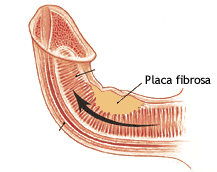
Peyronie's disease
Peyronie's disease refers to a curvature of the penis which appears as a consequence of the accumulation of fibrous plaque in the tunica alguginea of the corpora cavernosa of the penis producing a pulling effect and curving it in the process.
Is it common?
The appearance of fibrous plaque in the penis is relatively common. Some studies point to around 5% of men who might have this problem and about 2% could have a curvature of the penis as a result.
Why does it occur?
We do not know for certain why the fibrous plaque appear. Some factors such as the use of certain medication have traditionally been cited as possible causes. However nowadays researchers are working along the lines of Peyronie's being the result of an alteration of the auto-immune system which generates an excessive immune response (resulting in fibrosis) in response to small traumas suffered by the penis during intercourse.
On the other hand circumstances such as a testosterone deficiency or a previous fracture of the penis could be related to the curvature.
What are the symptoms?
Frequently Peyronie's disease manifests itself as penile pain especially during erection or intercourse. After some time the curvature may become evident. This is the phase known as “active”. Once the active phase is over the curvature stabilizes and the pain disappears.
Simultaneously Peyronie's disease has been proved to be related to the onset of erectile problems so it is important to explore this possibility when treating these men.



